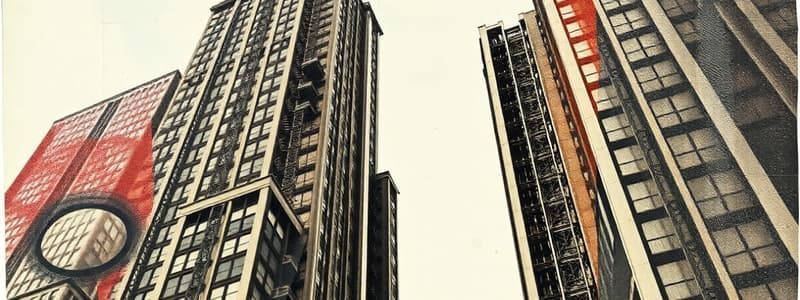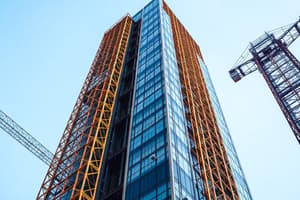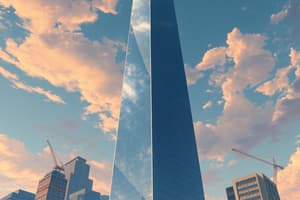Podcast
Questions and Answers
What material, which was new at the time, was used in the construction of skyscrapers due to its lighter weight and greater strength compared to iron?
What material, which was new at the time, was used in the construction of skyscrapers due to its lighter weight and greater strength compared to iron?
- Steel (correct)
- Brick
- Wood
- Concrete
Grand Central Station in New York City was recognized as an ordinary feat of architectural engineering.
Grand Central Station in New York City was recognized as an ordinary feat of architectural engineering.
False (B)
What is the definition of a 'skyscraper'?
What is the definition of a 'skyscraper'?
a very tall building of many stories
Elevators were also called '______'.
Elevators were also called '______'.
What distinguishes modern elevators from the earlier 'lifts'?
What distinguishes modern elevators from the earlier 'lifts'?
The Mackinac Bridge connects lower Michigan and Canada.
The Mackinac Bridge connects lower Michigan and Canada.
What was James Eads's prior experience before designing the bridge in St. Louis?
What was James Eads's prior experience before designing the bridge in St. Louis?
What did James Eads use to explore the Mississippi River before designing the bridge
What did James Eads use to explore the Mississippi River before designing the bridge
To dig down into the bedrock, the builders worked inside of huge airtight 'containers' called ______.
To dig down into the bedrock, the builders worked inside of huge airtight 'containers' called ______.
Workers could stay in the caissons for extended periods of time.
Workers could stay in the caissons for extended periods of time.
What does a bridge do?
What does a bridge do?
What was the primary source of inspiration for American architecture prior to the development of uniquely American styles?
What was the primary source of inspiration for American architecture prior to the development of uniquely American styles?
America's Victorian Age was marked by less decoration in houses.
America's Victorian Age was marked by less decoration in houses.
What state was the city of St. Louis in, that faced the challenge getting train tracks across the water.
What state was the city of St. Louis in, that faced the challenge getting train tracks across the water.
Match each architectural style/structure type with its origin or primary characteristic:
Match each architectural style/structure type with its origin or primary characteristic:
Flashcards
Skyscraper
Skyscraper
A very tall building of many stories.
Elevator
Elevator
A platform or compartment housed in a shaft for raising and lowering people or things to different floors, levels, or stories.
Bridge
Bridge
A structure carrying a road, path, railroad, or canal across a river, ravine, or other obstacles.
Steel
Steel
Signup and view all the flashcards
Caissons
Caissons
Signup and view all the flashcards
Mackinac Bridge
Mackinac Bridge
Signup and view all the flashcards
Study Notes
- Chapter 14 discusses skyscrapers, elevators, and bridges
Skyscrapers
- Skyscrapers are very tall buildings of many stories
- The need for more office space led to building upwards
- Americans were in awe as these buildings, which "scraped the sky," sprung up in cities
- Skyscrapers were made mostly of steel and glass, unlike most houses
- Steel was new, and was lighter and much stronger than iron
- Great lattice-works of frames were welded together from skeletons of these buildings
- Grand Central Station in New York City was called a masterpiece of architectural engineering
Elevators
- Elevators are a platform or compartment in a shaft for raising and lowering people or things to different floors, levels, or stories
- The construction of tall, multi-floored structures increased the need for an easier way to get between floors
- Elevators were originally called “lifts”
- These “lifts” were steam-powered, not like the quiet, electric elevators of today
- Steel is a material made of both iron and carbon
Bridges
- A bridge is a structure carrying a road, path, railroad, or canal across a river, ravine, road, railroad, or other obstacles
- The Mackinac Bridge is approximately five miles long and connects lower Michigan and its Upper Peninsula
- Many cities had been built next to rivers, so getting train tracks across the water was a growing issue
- St. Louis, Missouri, was one place with this problem, as the city had grown up on both sides of the Mississippi River
- James Eads, who built ironclad gunboats for the Union Navy during the Civil War, designed a bridge
- Eads had built a diving bell to explore the Mississippi River, and he knew his bridge would have to go far below the river bed
- The Mississippi has strong currents and churning waters
- Eads knew that a bridge would have to be footed in bedrock far below the surface of the river to stand strong
- The great bridge would have two giant stone towers to support it in the middle of the river
- The towers would be 50 feet above the river, with bases anchored between 86-125 feet below the water
Eads Bridge Construction
- Builders worked in huge airtight "containers” called caissons (CA-sons) to dig down into the bedrock
- Workers in the caissons had to deal with great pressure
- Each shift of workers could only stay down there for 15 minutes at a time and had to come up slowly to adjust to the pressure
- Other great bridges followed, changing America's landscape more
- Mountains and rivers, as well as deserts and plains, could not stand in the way of America's growth
Presidential Fact
- In the 1880s, James A. Garfield became the 20th president
- He served only 200 days in office, the second shortest time
- Garfield was assassinated, unlike William H. Harrison
- His vice president, Chester A. Arthur, then took over the presidency
Studying That Suits You
Use AI to generate personalized quizzes and flashcards to suit your learning preferences.




